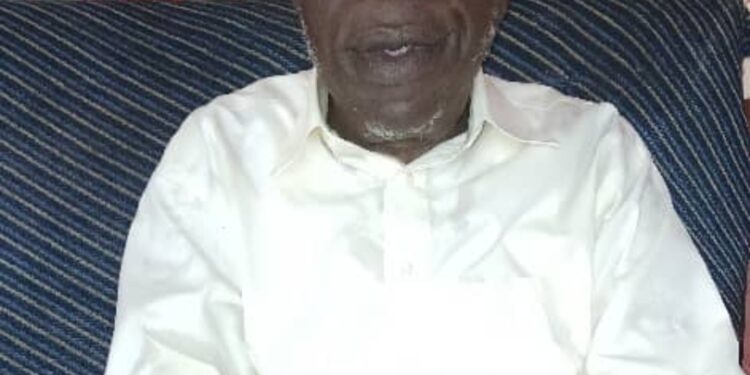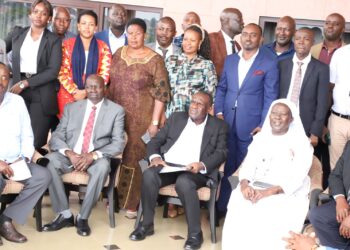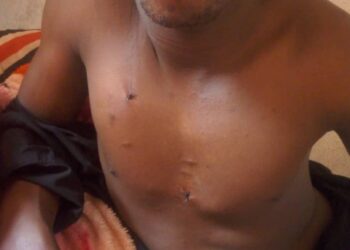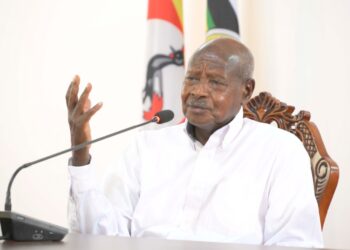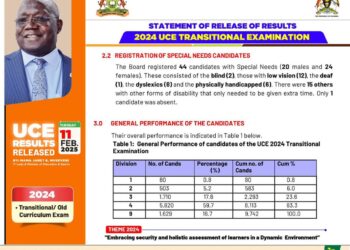A team of five individuals, led by retired chief technician Moses Teyite Magumba, under the organization Discovery of the Solution to the World (DISOW Efforts Ltd), has made a groundbreaking claim of developing 45 innovative products capable of treating various diseases.
Magumba, a 71-year-old former staff member of Jinja City-based Nafiri, asserts that their products have already yielded remarkable results with numerous patients experiencing significant improvement and even total healing from conditions like hypertension and diabetes, among others.
The herbal group, based at the dusty/muddy Mauta Cell, Buwekula Ward, Northern Division 6km from Jinja City was founded by Pastor Samuel Walube Obodha who claims he received a revelation from God to rise up and save humanity.
In a thought-provoking analogy, Moses Teyite Magumba compared the herbal and healthcare sector to a motor rally, where diverse stakeholders play distinct roles, like the driver and navigator, working together towards a common goal.
“…just as both occupants can perish in an accident, collaboration is crucial in healthcare to avoid crashing the system, in other words health is a cross cutting matter we are all in…”the aging retired chief technician explained.
Magumba also debunked the misconception that traditional medicine practitioners are harmful to society, stressing that differences in opinion and approach should not be construed as negativity.
He highlighted the significant contribution of plant extracts, revealing that 70% of modern medicines are derived from plants, with only 30% being synthetic.
The group is now calling on President Yoweri Museveni to step forward and support Uganda’s herbalists, seeking an appointment to present their innovative products and showcase their potential.
By embracing traditional knowledge and practices, Magumba believes that Uganda can revolutionize its health care system.
“…let us work together to create a healthcare system that values diversity and promotes inclusivity, we are not asking for replacement, but complementarily because together we can achieve far more than we can alone…Maguma urged.
He also envisions a revolutionary approach to healthcare in Uganda, a holistic approach that integrates the three pillars of divine, nature, and science.
He says the holistic method recognizes the interconnectedness of these elements and seeks to reunite them, moving away from the current independent practices.
“…the three are complementary forces that, when harmonized, can unlock unprecedented healing potential, and by embracing this synergy, Uganda can break free from the limitations of fragmented healthcare approaches…”, he observed.
As one way of sensitizing the people of Uganda on their new products, Pastor Samuel Obodha announced that plans are underway to organize a symposium in Jinja City.
A symposium is a formal gathering of experts, researchers, and stakeholders to discuss and share knowledge on a specific topic or theme.
It’s an academic or science conference where selected participants present papers, research findings, or innovative ideas, followed by discussions, debates, and networking.
In the context of DISOW Efforts Ltd, Pastor Obodha says they will use the symposium to showcase their innovative products and facilitate discussions on the integration of divine, nature, and science in healthcare.
He says they will also bring together stakeholders from traditional medicine, nutritionists, modern healthcare, and the government to seek a constructive and harmonious way of operation.
By holding the symposium, the group aims to educate, raise awareness, and build support for their holistic approach to healthcare, ultimately driving positive change in Uganda’s health sector.
DISOW Efforts Ltd is a registered company in health programmes by providing proper hygiene practices and nutrition supplements to HIV/AIDS patients with emphasis on moral and spiritual rehabilitation.
Aware that this revelation can attract widespread and harsh reactions from some stakeholders, Magumba defended their project urging the government agencies led by the Ministry of Health to embrace the initiative instead of mere sweeping condemnations.
Call For Validation:
Magumba now wants the relevant government authorities like the National Drug Authority (NDA) to support and begin the validation processes of their 45 products, which will go a long way to helping citizens and people in Africa.
Information available on the Validation Process says once a traditional health practitioner has identified herbal medicine that has proven effective, he or she may take it to the Natural Chemotherapeutics Research Laboratory (NCRL), providing information on contents and effects.
The unprocessed product is then tested in the 1963 NCRL facility based in Kampala. When a practitioner presents herbal medicine already in use, he or she is requested to submit samples of individually processed ingredients.
He or she is also required to submit whole samples (leaf, seed, root, and flower) for authentication.
These may be used as specimens at the Makerere University reference herbarium. The samples are all analyzed for standard therapeutic phyto-components and toxic substances.
The formula is also subjected to toxicity tests in rats or mice. In some cases, the medicine is sent to Ethiopia as part of a collaborative network to further identify and test content, safeguard, and efficacy.
A report on outcomes in terms of chemical ingredients, implied pharmacological effects, and observed toxicity is generated and used to inform the herbalist about the safety of his formulation. In cases where the validation results are positive, he is encouraged to have his product notified by the NDA.
Once validated, NCRL may also test a remedy on a few patients after registering with the Uganda National Council of science and technology and monitor their response before the practitioner may take the herbal medicine for registration.
What You Need To Know:
CAM is a group of diverse medical and health care systems, practices, and products that are not presently considered to be part of conventional medicine.
The list of practices that are considered as CAM changes continually as CAM practices and therapies that are proven safe and effective become accepted as the “mainstream” healthcare practices.
Today, CAM practices may be grouped within five major domains: alternative medical systems, mind-body interventions, biologically-based treatments, manipulative and body-based methods, and energy therapies.
According to antiquities, traditional complimentary and alternative medicine is a system of healing that dates back to 200 B.C. in written form.
It is estimated that in the United States of America (USA), TCAM is used by approximately one-third of the population.
In European countries where statistics are available, it is estimated that TCAM treatment is being utilized by 20-50% of the population, and in the United Kingdom, this may amount to one in four people.
Furthermore, up to 80% of the people in developing countries rely on TCAM, specifically traditional medicine, for their primary health care due to cultural traditions or lack of alternative.
China, Korea, Japan, India, and Vietnam have all developed their own unique versions of traditional medicine.
Alternative medicine is commonly categorized together with complementary medicine under the umbrella term “complementary and alternative medicine”.
Complementary medicine refers to therapies that complement traditional western (or allopathic) medicine and is used together with conventional medicine, and alternative medicine is used in place of conventional medicine.
Alternative medicine refers to therapeutic approaches taken in place of traditional medicine and used to treat or ameliorate disease.
Integrative medicine refers to combining complementary treatments with conventional care.
The basic philosophy of complementary and alternative medicine includes holistic care, which focuses on treating a human being as a whole person.
Examples of complementary and alternative medicine healing systems include Ayurveda, which originated in India more than 5,000 years ago, and emphasizes a unique cure per individual circumstances.
It incorporates treatments including yoga, meditation, massage, diet, and herbs; homoeopathy uses minute doses of a substance that causes symptoms to stimulate the body’s self-healing response. Naturopathy focuses on non-invasive treatments to help your body do its own healing.
Ancient medicines (complementary and alternative medicine treatments) include Chinese, Asian, Pacific Islander, and American Indian and Tibetan practices.
Conventional medicine relies on methods that proved to be safe and effective with carefully designed trials and research. But, many complementary and alternative treatments lack solid research on which to base sound decisions. The dangers and possible benefits of many complementary and alternative treatments remain unproved.
While the whole medical systems differ in their philosophical approaches to the prevention and treatment of disease, they share a number of common elements. These systems are based on the belief that one’s body has the power to heal itself.
Healing often involves marshalling multiple techniques that involve the mind, body, and spirit. Treatment is often individualized and dependent on the presenting symptoms.
Basic principles of integrative medicine include a partnership between the patient and the practitioner in the healing process, the appropriate use of conventional and alternative methods to facilitate the body’s innate healing response, the consideration of all factors that influence health, wellness and disease, including mind.
Spirit and community as well as body, a philosophy that neither rejects conventional medicine nor accepts alternative medicine uncritically, recognition that good medicine should be based on good science.
Inquiry driven and open to new paradigms, the use of natural, less invasive interventions whenever possible, the broader concepts of promotion of health and the prevention of illness as well as the treatment of disease.
Studies are underway to determine the safety and usefulness of many CAM practices.
As research continues, many of the answers about whether these treatments are safe or effective will become clearer.
According to a newsletter, Promoting Herbal Medicine in Uganda, commissioned by Cross Cultural Foundation of Uganda, more than 60% of Uganda’s population depends on traditional medicine because it is accessible, affordable and culturally familiar.
With an estimated health practitioner for every 200-400 Ugandans compared to western-trained doctor per 20,000, herbal medicine has been long used to manage a range of common conditions, including malaria, digestive and respiratory problems, toothaches, skin diseases and childbirth complications.
Do you have a story in your community or an opinion to share with us: Email us at editorial@watchdoguganda.com


